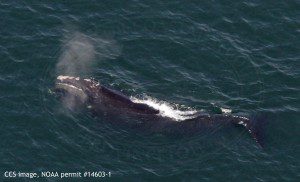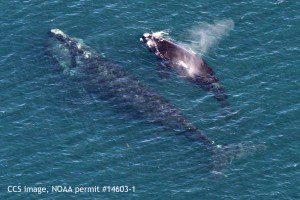March
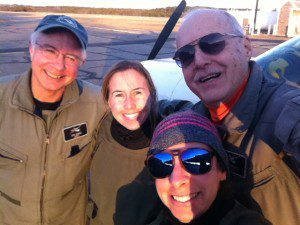
March 1 Aerial Survey Team. L-R: NESAS pilot Bob Bisbee, CCS aerial observer Brigid McKenna, CCS flight co-ordinator Corey Accardo, and NESAS pilot Joe Chronic.
March 1, 2016
The CCS aerial team flew again on Tuesday afternoon, this time starting from the south, where the right whales seemed to be concentrated during the last flight on Saturday.
We took off from Chatham around noon, having allowed for winds to come down, and the first few track lines were pretty quiet, with only a pair of right whales observed.
That changed when we got to the central-eastern portion of the bay, off Jeremy’s Point in Wellfleet. There we had 10 right whales within about a 3 mile radius! They were seemingly popping up all around and then diving with flukes up below the surface, so there was a lot of circling to document everyone. One individual breached at least four times – it was the first time this behavior has been seen this season, and was an incredible sight from the plane. After continuing on survey we observed 3 more right whales scattered in the northern part of Cape Cod Bay. One of these whales had injuries which appeared to be from an entanglement.
The survey was completed with one last sighting of an unknown large whale on the backside.
This has been the most right whales documented in a day so far in 2016, and interestingly enough most of the whales seemed to be new this season. So even though we had 13 animals on our last flight only a few days prior, we only saw a few of them this flight. Needless to say it will be interesting to see what the next survey and the rest of the season holds.
We would like to take this opportunity to express our deepest appreciation and thanks to NESAS pilot Bob “Biz” Bisbee for his five years of dedication and assistance to the project and the whales!
Sunday, March 4
With a wide open weather window Sunday, the CCS right whale aerial survey team took advantage of a wide open weather window. Despite snow flurries off Chatham early in day, there were soon blue skies as far as the eye could see. Flying the track-lines from north to south, we saw our first right whales off Great Island in Wellfleet. Fifteen whales were scattered individually and in pairs, mostly conducting long dives prefaced by a raised fluke. Two more right whales were documented on this same latitude just a little further west. After a quick refuel in Chatham the team finished the survey, documenting four more right whales in the southern portion of Cape Cod Bay.
There were a few familiar faces in the Bay, including EGNO 1817, “Silt,” a reproductive female who has had 3 calves, the most recent in 2009. Silt is at least 28 years old and a regular visitor to Cape Cod Bay. For the most part there appears to be some exchange of individuals coming in and out of the Bay. It seems that the activity has been gradually picking up as time progresses so it will be interesting to find out who we see, what they are doing, and where they are in the Bay on the next flight.
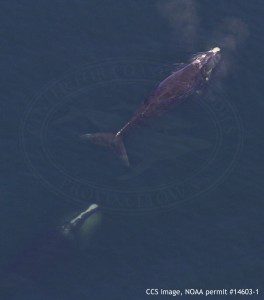
Right whales EgNo 3740 and 1817 (Silt) echelon (coordinated) feeding in Cape Cod Bay on March 8, 2016
Tuesday, March 8
Tuesday was a perfect day to fly and be on the water! With the sea state perfectly calm with only slight ripples, CCS had researchers out on two boats and the aerial team up in the air. The aerial team flew Cape Cod Bay from the South and found right whales on the second track line surveyed. A whopping 38 right whales were observed today, the most seen in one day so far this season.
Along with the increased numbers, a noticeable shift in behavior and distribution was documented. Most individuals sighted were subsurface feeding, which makes the plankton samples collected by the vessel based habitat team really important. Some right whales were even coordinated feeding, where two or more animals are next to each other or when one is slightly behind another animal. Both teams are busy in the lab working on analyzing samples and identifying right whales that were photographed.
Interestingly, we had a mix of both new whales and whales previously documented by the CCS team earlier this season. Some repeats from earlier flights are Silt, EgNo 1817, last seen on Sunday’s flight, and Aphrodite, EgNo1701, previously seen on January 30, 2016. We also had Wolverine, EgNo4023; Wolverine is a five year old male, seen by CCS every year (except 2012) since his birth in 2010.
After flying for just over four hours, documenting whales on seven of our 16 track lines, the team landed to refuel with the intent to finish surveying the remaining northern transects. Unfortunately, due to circumstances out of our control the survey could not be resumed. The aerial team is already counting down the days until they can get back in the air to see if the whales are here to stay for the rest of the season!
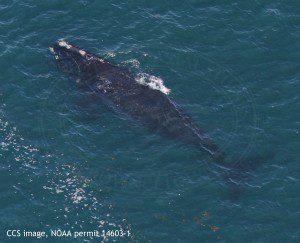
Unknown right whale traveling through Cape Cod Bay on March 19, 2016. CCS image, NOAA permit #14603-1
Saturday, March 19
The CCS aerial team had a very short weather window, but was able to complete a full survey of Cape Cod Bay. Despite the choppy seas early in the survey we were able to see several fin whales in the northern portion of the Bay. The wind soon dropped and we began spotting right whales; eight individuals were observed south of Provincetown, then another four in the central part of Cape Cod Bay. After a brief break to refuel the survey continued and two more right whales were observed.
The total number of whales observed today was 14, but because they were taking long dives with short surface intervals we were only able to photograph about half of them. This total is far lower than was documented last week, but it’s possible that this is a function of the fact that the whales spent relatively more time underwater during this survey period, i.e. they may well have been in the Bay, but we may not have been in the right place at the right time to see them.
Sunday, March 27
The field conditions on Easter Sunday were gorgeous, and the team got an early start to take advantage of the beautiful weather. Today’s survey was flown north to south, and while on the track line east of Cape Cod, from Chatham to Provincetown, the first humpbacks of the season were sighted bubble net feeding and travelling.
The excitement did not stop there – a total of 85 right whales were documented throughout the Bay on this this two flight survey day! This is the most right whales documented in 2016. Nearly all individuals were skim or subsurface feeding, indicating the food resource is the reason why so many animals were observed. The main concentration was in a near perfect line from Wood End south to Truro, and another densely occupied area north of the canal. A lot of familiar faces were sighted, including a 12 year old male named Ruffian, a 22 year old male named Shackleton (named because of his “expedition” up the Delaware River), and a 29 year old female named Wolf who brought her calf to Cape Cod Bay last season.
And wait – there’s more! The first sighting of a mom-calf pair in the northeast this season! This mom, EGNO 1233 is at least 42 years old, has had 5 known calves prior to this plump one, and has only been seen in Cape Cod Bay twice with the most recent sighting in 2011. The excitement was palpable and it was a great addition to an already wonderful day. Everyone involved in the Right Whale Ecology Program here at CCS is keen to see what we find next time we are out on the water and in the air.
Wednesday, March 30, 2016
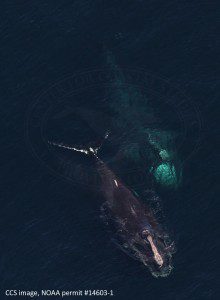
Right whale #1320, Mohawk and unknown individual feeding in Cape Cod Bay on March 30, 2016. CCS image, NOAA permit #14603-1
The forecast was for increasing winds, so we took off early to make the most of the calm weather. Conditions for the first flight of the day were beautiful. We observed a large number of humpback and fin whales in the north of Cape Cod Bay, and around 50 right whale sightings deeper into the Bay. After a quick refuel at the Chatham Municipal Airport we returned to complete the last few track lines in the southern part of the bay, and despite building winds and white caps as far as the eye could see we still documented close to 30 more right whales before the end of the survey.
The distribution of right whales in the Bay had changed from just four days prior, as several individuals observed on the last flight – including #1233 and her calf – were nowhere to be seen. However, we did see old favorites Legato, a 28 year old breeding female who frequently visits Cape Cod Bay, and Black Heart, the 2005 calf of the infamous Wart, and a previous mom herself.

Our Work
Humpback Whale Research
Right Whale Research
Marine Animal Entanglement Response
Marine Geology Department
Water Quality Monitoring Program
Marine Fisheries Research
Seal Research
Shark Research
Marine Education
Interdisciplinary
Marine Debris and Plastics Program
Marine Policy Initiative
Cape Cod Climate Change Collaborative
Publications

